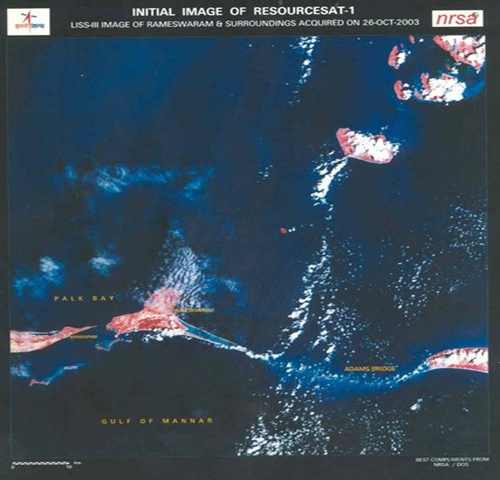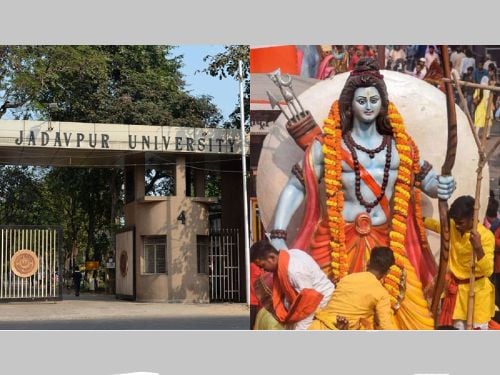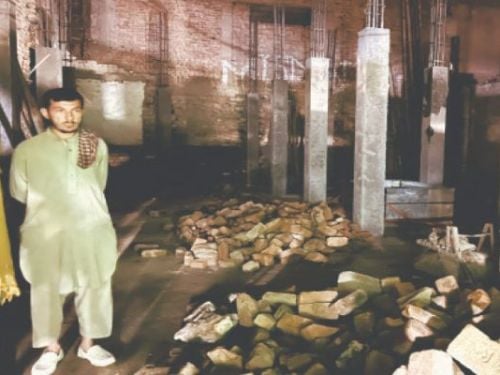 |
Satellite image produced by National Remote Sensing Agency, ISRO using Resourcesat-I
Hyderabad: The National Remote Sensing Agency (NRSA), of the Union Ministry of Space has published a book of satellite photographs [ISBN: 817525 6524] claiming that "archeological studies show" that the Setu may be "man made" (see above photo). This book has been distributed to all MPs free by the Ministry of Space. Yet Ms. Ambika Soni as Minister of Culture to a question in Rajya Sabha (August 14, 2007) falsely stated that "no archeological studies has been made in respect of the Rama Setu". This is a breach of privilege of the House, for which she should be punished.
The Ramar Sethu, which is under much focus, could be ‘man-made and has an echo in the ancient epic, the Ramayana’, concurs a government publication tabled in parliament last week.
This publication could put the Congress-led government in a piquant spot as its hardline allies like the DMK has been trying to push the Sethusamudram project demolishing this historic and sacred link.
A book ‘Images India’ published by the Hyderabad-based National Remote Sensing Agency (NRSA) that comes under the Department of Space, says the satellite images have revealed an ‘ancient bridge between India and Sri Lanka in Palk strait’.
‘The origin of the bridge is a mystery. Archaeological studies have revealed that the bridge dates back to the primitive age that is about 1,750,000 years.’
‘Its structure suggests that it may be man-made,’ it says on page 39 of the coffee table book under the sub-title ‘Stunning Structures’. ‘This 30 km long bridge, named as Adam’s bridge, is made of a chain of shoals and links Rameshwaram in the south India to Sri Lanka.’
It goes on to say: ‘This has an echo in the ancient Indian epic, the Ramayana. According to the epic, such a bridge was built by Lord Rama and his followers to reach Sri Lanka. Studies are still on but the bridge is seen as an example of ancient history.’
The revelations in the book, with a foreword by Indian Space Research Organisation (ISRO) chairman G Madhavan Nair, are in contrast to what the government has been maintaining so far that the Sethu is formed by giant tombolos – bars of sand connecting an island with another island of the mainland.
It also contradicts the findings of the Archaeological Survey of India (ASI), which says there is no ‘historic or scientific’ evidence of the existence of Lord Ram or Ram Sethu.
The government has given the nod to a multi-million dollar Sethusamudram Shipping Canal Project, which requires breaking a portion of Ram Sethu to make a route navigable for ships around the Indian peninsula.
Source: newstodaynet.com

 Rajasthan: Woman found hanging at a beauty parlour, Arshad, 3 others booked
Rajasthan: Woman found hanging at a beauty parlour, Arshad, 3 others booked Jadavpur Univ revokes permission to celebrate Ram Navami on campus after granting it
Jadavpur Univ revokes permission to celebrate Ram Navami on campus after granting it Andhra Pradesh: Farooq kills mentally challenged Hindu man for insurance money
Andhra Pradesh: Farooq kills mentally challenged Hindu man for insurance money Pakistan: Ancient Hindu temple in Khyber Pakhtunkhwa demolished for commercial complex
Pakistan: Ancient Hindu temple in Khyber Pakhtunkhwa demolished for commercial complex Bihar: Goddess Bhagavati Temple in Araria vandalised and deities damaged
Bihar: Goddess Bhagavati Temple in Araria vandalised and deities damaged Vadodara: Beef supplier Imran Qureshi arrested in beef-stuffed samosa case
Vadodara: Beef supplier Imran Qureshi arrested in beef-stuffed samosa case